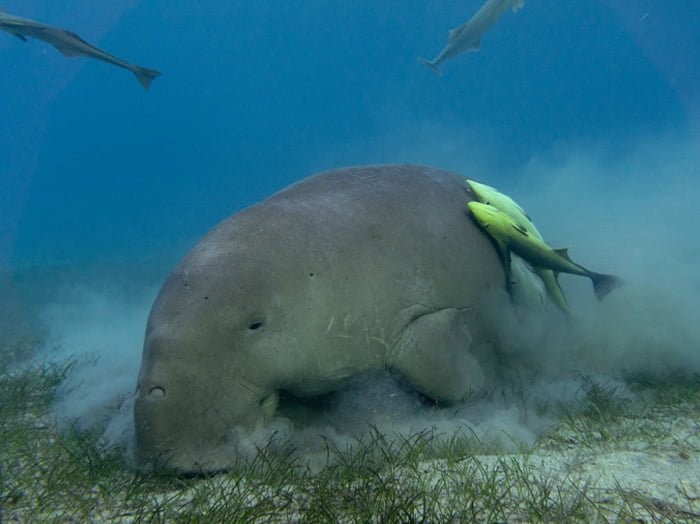Dugongs (Dugong dugon) are found in coastal waters across the Indo-Pacific. They are members of the order Sirenia, whose closest relatives are elephants, and are the only surviving species of the family Dugongidae.
The dugong’s range includes over 40 countries from East Africa to Vanuatu in the Pacific, with Australia being home to the largest remaining population. Also known as sea cows, dugongs are the only fully herbivorous marine mammal, relying on seagrass for their primary food. A mature dugong can consume up to 50kg of seagrass a day. Dugongs are slow growing, reaching up to three metres in length and weighing up to 500 kilograms. They are known to live for a long time, with the oldest recorded dugong reaching 73 years old.

Females produce their first calf between 6-18 years old and have a 14-month gestation. A newborn calf will suckle milk for up to 18 months and starts transitioning to seagrass as its main nutritional source, from only a couple of weeks after birth. Under ideal conditions, females will reproduce every 3-7 years. While they do suckle for up to 18 months, they start eating seagrass (including the rhizomes) from only a couple of weeks after birth.
The biological characteristics of dugongs and their lifestyle make them highly vulnerable to threats. They take a long time to reach sexual maturity and produce few calves in their lifetime, making it hard for dugong populations to recover from impacts that deplete their numbers, particularly adults. Human activities are a major threat to dugongs: they are affected by seagrass habitat loss, collision with boats, poaching, by-catch in fishing gear and pollution.
The biological characteristics of dugongs and their lifestyle make them highly vulnerable to threats.
Dugongs are classified as vulnerable to extinction by the International Union for the Conservation of Nature (IUCN), indicating that there is a high risk of extinction in the wild in the medium-term future. The Convention on the Conservation of Migratory Species of Wild Animals (CMS) lists dugongs in Appendix II, indicating that international cooperation across jurisdictional boundaries within the dugong migratory range is essential for the dugong’s long-term survival.
Dugongs are at high risk of extinction in the wild in the medium-term future.